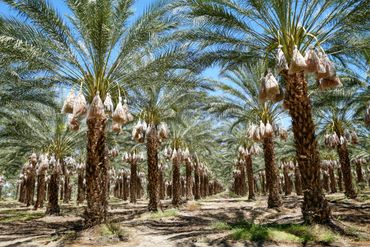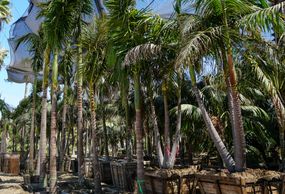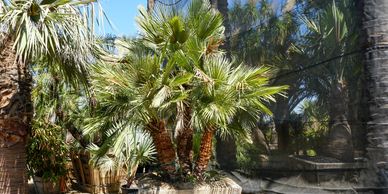Hot sellers!








Palms Available
Archontophoenix Cunninghamiana

The King Palm Tree, scientific name Archontophoenix cunninghamiana, is one of the most popular palms in tropical and subtropical climates. The King palm looks very nice when planted in a grouping of 2 or 3. This sun-loving palm is mostly used outdoors, but it also makes an excellent house plant if given the right environment. While King palm is young, it can be kept inside in the container to avoid cold exposure.
Brahea Armata

The Mexican Blue Palm Tree, scientific name Brahea armata, is one of the most popular palm trees in California, because of its unique appearance and low maintenance. This stunning palm would be a great focal point for any landscape. Can also be grown indoors in a container. Brahea armata can tolerate cold temperatures down to 15F and can be grown in states like Alabama, Arizona, California, Georgia, Louisiana, Mississippi, Nevada, North Carolina, Oregon, Texas and Virginia.
Butia Capitata

The Pindo Palm Tree, scientific name Butia capitata, is one of the most popular palms in the world because of its stunning appearance, cold hardiness and bright yellow fruit, that can be made into a jelly. Its graceful appearances with blue-green fronds make it great for pool-side plantings, and also for container use. It is one of the most popular Florida Palm Trees. The Pindo Palm can live up to 80 years.
Brahea Edulis

The scientific name for the Guadalupe Palm is – Brahea edulis. Guadalupe Palm is native to Guadalupe Island off of the Western coast of Mexico. This palm is cold hardy down to 20F and can be grown in states like Georgia, Louisiana, Nevada, Oregon, South Carolina, Texas, and Washington.
Chamaerops Ceriferas

Chamaerops humilis var. cerifera is a variety of the deer-resistant European fan palm that hails from the Atlas Mountains of Morocco where it grows up to 5,400' elevation. Instead of green foliage like the species, this variety has powder-blue foliage with silver undersides similar to Brahea armata.
Chamaerops Humilis

The European Fan Palm Tree, scientific name Chamaerops humilis, has become very popular in recent years, mostly due to its cold hardiness that makes it perfect for landscape in USDA zones 7b-11. It’s a nice looking palm tree that can give exotic focal point to any garden with its evergreen fan-shaped leaves. Since it grows only to about 10ft tall, it is often used in small yards.
Dypsis Decaryi

The Triangle Palm Tree, scientific name Dypsis decaryi, is a very striking palm known for its tristichously arranged leaves that form a triangle. The palm is a great ornamental plant that can be grown indoors or outdoors in the open to show its unique shape.
Dypsis Lutescens

The Areca Palm Tree, scientific name Chrysalidocarpus lutescens, is one of the most popular palms in tropical and subtropical climates because of its beautiful appearance and low maintenance. This palm can be grown indoors as well as outdoors.
Howea Forsteriana

The Kentia Palm Tree, scientific name Howea forsteriana, is by far the most popular indoor palm because of its durability and elegant appearance. The Kentia Palm Tree doesn’t require much maintenance and can easily adapt to a wide ranges of soil conditions. The Kentia Palms grow more quickly as singles than in the plant groupings.
Phoenix Canary

The Canary Date Palm Tree, scientific name Phoenix canariensis, is easily recognized through its crown of leaves and trunk characteristics. This is a large palm that can tolerate cold down to 15F making it perfect for growing in zone 8b. It is very easy to grow, but does require some maintenance in order to keep its nice appearance.
Phoenix Dactyliferas

The True Date Palm Tree, scientific name Phoenix dactylifera, is a close relative to Canary Date Palm (Phoenix canariensis) and Pygmy Date Palm (Phoenix roebelenii). This is a cold hard palm that can tolerate cold temperatures down to 15F and will grow in the zone 8. This palm tree can also withstand large temperature fluctuations. Phoenix dactylifera is very easy to grow and maintain. This palm can be grown in states like Alabama, Arizona, Arkansas, California, Georgia, Louisiana, Mississippi, Nevada, Oregon and Texas.
Phoenix Reclinata

This beautiful and unusual palm grows in huge clumps that can make a striking statement in the landscape. The Senegal date palm is variable in shape and form but tends to grow as clumps composed of multiple stems reaching 25 ft (7.6m) to 50 ft (15 m) in height. These slender stems are covered with brown fiber and tend to curve away from the center of the clump in graceful arcs. They are topped by crowns of dark green to yellow green pinnate (feather shaped) fronds.
Rhapis Excelsa

The Lady Palm Tree, scientific name Rhapis excelsa, is very popular indoor and outdoor palm because of its easy maintenance and cold hardiness which makes it a great choice for landscape in USDA zones 8b-11. Lady Palms adapt to a wide range of climates, soils, and environments. It will happily live under low light conditions or bright filtered light. This palm can be grown in states like Alabama, Arizona, Arkansas, California, Georgia, Louisiana, Mississippi, Nevada, Oregon and Texas.
Trachycarpus Fortunei

The Windmill Palm Tree, scientific name Trachycarpus fortunei, is one of the most popular palms because of its cold hardiness that makes is perfect for landscapes in USDA zones 7-11. This palm can be grown in states like Alaska, Alabama, Delaware, Maryland, Massachusetts, Mississippi, New Jersey, New York, Oklahoma, Tennessee and more. It is very easy to grow and maintain. Can also be grown indoors.
Syagrus Romanzoffiana

The Queen Palm Tree, scientific name Syagrus romanzoffiana, is one of the most popular palms in tropical and subtropical climates because of its beautiful appearance and low maintenance. The Queen Palm is also known as Cocos Plumosa, and Jeriva Syagrus romanzoffiana. Syagrus romanzoffiana has smooth single trunk ringed with leaf scars and topped with dark
Washingtonia Filifera

The California Fan Palm Tree, scientific name Washingtonia filifera, is one of the most popular palms in subtropical climates because of its beautiful appearance and low maintenance. This is a large tree that can tolerate cold down to 15F making it perfect for growing in zone 8b. This palm can be grown in states like Alabama, Arizona, Arkansas, California, Georgia, Louisiana, Mississippi, Nevada, Oregon and Texas.
Washingtonia Hybird

Similar and intermediate to both its parents. Differing from W. filifera in its more slender stem; smaller, denser leaf canopy; smaller, brighter green leaves with a small patch of white tomentum abaxially at petiole and blade junction; and shorter inflorescences. Differing from W. robusta in its more robust stem not abruptly flared at the base; larger, more expansive canopy; larger, but lighter, medium green leaves; and longer inflorescences.
Washingtonia Robusta

The Mexican Fan Palm Tree, scientific name Washingtonia robusta, is very popular indoor and outdoor palm because of its striking appearance and cold hardiness which makes it a great choice for landscape in USDA zones 8b-11.This is a cold hardy, drought resistant and inexpensive palm that doesn’t require a lot of maintenance. Washingtonia robusta can be grown in states like Alabama, Arizona, Arkansas, California, Georgia, Louisiana, Mississippi, Nevada, Oregon and Texas.
Copyright © 2019 Prime Landscape Development - All Rights Reserved.